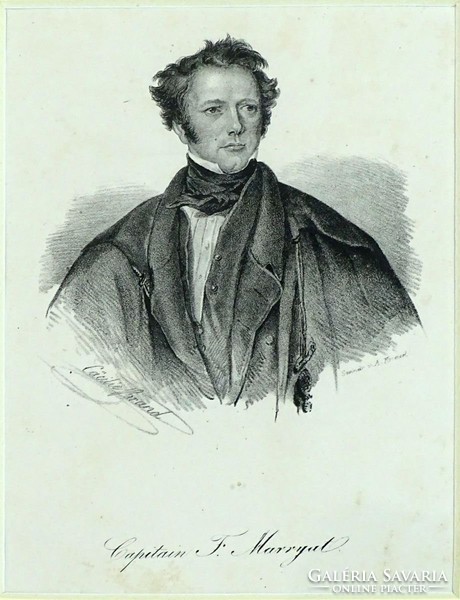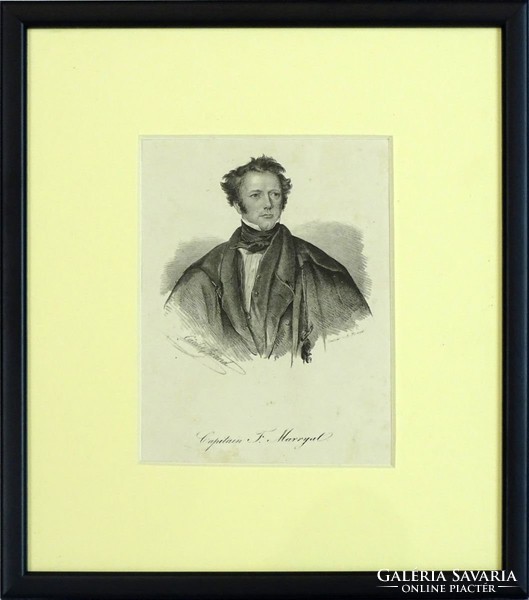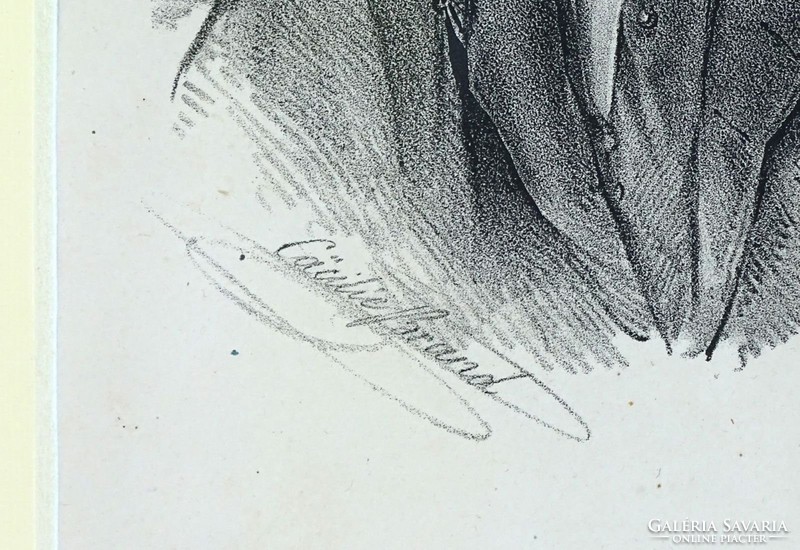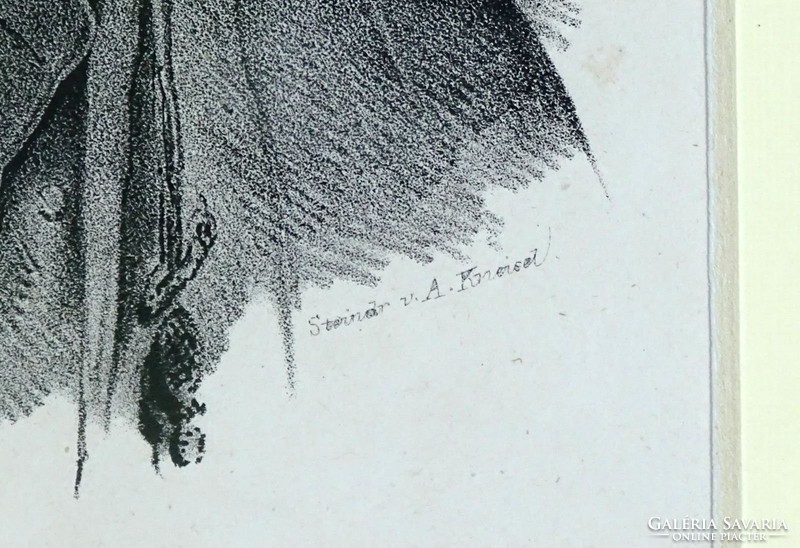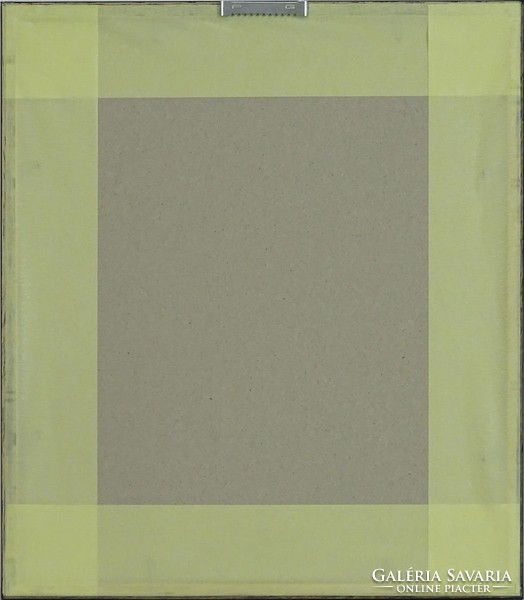0J243 Antik acélmetszet CAPITAIN F. MARRYAT
| Feltöltés ideje: 2023. december 04. |
| Termékkód: 1367152 |
| Megtekintések: 84 |
| Megfigyelők: 0 |
| Ajánlatok: 0 ajánlat |
antikvitasok (3013)
![]() BUDAPEST
BUDAPEST
Hitelesített felhasználó
Tudja meg, milyen lépésekkel tesszük biztonságosabbá és kényelmesebbé online piacterünk használatát. Részletek
| Téma: | portré |
| Eredetiség: | eredeti |
Szépen keretezett, paszpartuban és üveglap mögött található hibátlan, ajándékozható állapotban lévő acélmetszet portré.
A képen látható személy:
CAPTAIN F. MARRYAT
(Frederick Marryat)
Kép alatt aláírás, jelzés:
CÄCILIE BRAND
STEINDR V.A. KNEISET
Szélesség: 27 cm
Magasság: 31 cm
Súly: 0.63 kg
Portré mérete: 13 x 16,5 cm.
Frederick Marryat
From Wikipedia, the free encyclopedia
Frederick Marryat
Portrait by John Simpson, 1826
Born
10 July 1792
Westminster, London, Great Britain
Died
9 August 1848 (aged 56)
Langham, Norfolk, United Kingdom
Occupation
Royal Navy officer, writer, novelist
Nationality
British
Period
19th century
Genre
Sea stories and children's literature
Captain Frederick Marryat (10 July 1792 – 9 August 1848[1]) was a British Royal Navy officer, a novelist, and an acquaintance of Charles Dickens'. He is noted today as an early pioneer of the sea story, particularly for his semi-autobiographical novel Mr Midshipman Easy (1836), for his children's novel The Children of the New Forest (1847), and for a widely used system of maritime flag signalling, known as Marryat's Code.
Contents- 1Early life and naval career
- 1.1After the war
- 2Literary career
- 3Works
- 4Notes
- 5References
- 6External links
Early life and naval career
Marryat was born in Great George Street, Westminster, London,[2] the son of Joseph Marryat (1757–1824), a "merchant prince" and member of Parliament, and his American wife Charlotte, née von Geyer.[3] After trying to run away to sea several times, Marryat was permitted to enter the Royal Navy in 1806 as a midshipman on board HMS Imperieuse, a frigatecommanded by Lord Cochrane (who later served as inspiration for Marryat as well as other authors).
Marryat's time aboard the Imperieuse included action off the Gironde, the rescue of a fellow midshipman who had fallen overboard, captures of many ships off the Mediterraneancoast of Spain, and the capture of the castle of Montgat. The Imperieuse shifted to operations in the Scheldt in 1809, where Marryat contracted malaria; he returned to England on the 74-gun HMS Victorious.
After recuperating, Marryat returned to the Mediterranean in the 74-gun HMS Centaur and again saved a shipmate by leaping into the sea after him. He then sailed as a passenger toBermuda in the 64-gun HMS Atlas, and from there to Halifax, Nova Scotia on the schooner HMS Chubb, where he joined the 32-gun frigate HMS Aeolus on 27 April 1811.
A few months later, Marryat again earned distinction by leading the effort to cut away the Aeolus's mainyard to save the ship during a storm and, continuing a pattern, he also saved one of the men from the sea. Shortly thereafter, he moved to the frigate HMS Spartan, participating in the capture of a number of American ships (the War of 1812 having begun). On 26 December 1812, he was promoted to lieutenant, and as such served in the sloop HMS Espiegle and in HMS Newcastle. Marryat led four barges from the latter ship on a punishing raid to Orleans, Massachusetts on December 19, 1814, the last combat in New England during the war. The affair had mixed results. Initially, Marryat cut out an American schooner and three sloops, but managed to escape with just one sloop. The local militia avoided casualties while killing one Royal marine.[4] He was promoted to commander on 13 June 1815, just as peace broke out.
After the war
Marryat then turned to scientific studies. He invented a lifeboat, which earned him a gold medal from the Royal Humane Society and the nickname "Lifeboat". Based on his experience in the Napoleonic Wars escorting merchant ships in convoys, he developed a practical, widely used system of maritime flag signalling known as Marryat's Code. During his scientific studies in 1818, he described a new gastropod genus Cyclostrema with the type speciesCyclostrema cancellatum Marryat, 1818.
In 1819, Marryat married Catherine Shairp, with whom he had four sons (of whom only the youngest Frank outlived him) and seven daughters, including Florence, a prolific novelist and his biographer; Emilia, a writer of moralist adventure novels in her father's vein; and Augusta, also a writer of adventure fiction. Around this time, Marryat collaborated with George Cruikshank the caricaturist to produce The New Union Club, an extravagant satire againstabolitionism.[5]
In 1820, Marryat commanded the sloop HMS Beaver and temporarily commanded HMS Rosario for the purpose of bringing back to England the despatches announcing the death of Napoleon on Saint Helena. He also took the opportunity to make a sketch of Napoleon's body on his deathbed, which was later published as a lithograph. His artistic skills were modest, but his sketches of shipboard life above and below deck have considerable charm.[6]
In 1823, he was appointed to HMS Larne and took part in an expedition against Burma in 1824. (This expedition resulted in large losses due to disease.) He was promoted to command the 28-gun HMS Tees, which gave him the rank of post-captain. He was back in England in 1826. In 1829, he was commanding the frigate HMS Ariadne on a mission to search for shoals around the Madeira and Canary Islands. This was an uninspiring exercise and, between that and the recent publication of his first novel The Naval Officer, he decided to resign his commission in November 1830 and take up writing full-time.
Literary career
From 1832 to 1835, Marryat edited The Metropolitan Magazine.[3] Additionally, he kept producing novels; his biggest success came with Mr Midshipman Easy in 1836. He lived in Brussels for a year, travelled in Canada and the United States, then moved to London in 1839, where he was in the literary circle of Charles Dickens and others. He was in North America in 1837 when the Rebellion of that year broke out in Lower Canada, and served with the British forces in suppressing it.
Marryat was named a Fellow of the Royal Society in recognition of his invention and other achievements. In 1843, he moved to a small farm at Manor Cottage in Norfolk, where he died in 1848. His daughter Florence Marryatlater became well known as a writer and actress. His son Francis Samuel Marryat completed his late novel The Little Savage.[7]
Marryat's novels are characteristic of their time, with concerns of family connections and social status often overshadowing the naval action, but they are interesting as fictional renditions of the author's 25 years' experience at sea, and were much admired by men such as Mark Twain, Joseph Conrad, and Ernest Hemingway. They were among the first nautical novels, serving as models for later works by C. S. Forester and Patrick O'Brian, also set in the time of Nelson and telling of young men rising through the ranks through successes as naval officers.
Along with his novels, Marryat was known for his short writings on nautical subjects. These short stories, plays, pieces of travel journalism, and essays appeared in The Metropolitan Magazine too, and were later published in book form as Olla Podrida. Marryat's 1839 Gothic novel The Phantom Ship contained The White Wolf of the Hartz Mountains, which includes the first female werewolf in a short story.[8]
In 1839, Marryat also published his Diary in America, a travelogue that reflects his criticisms of American culture and society. The book and the author were both subject to acts of violence, including the burning of the book and of Marryat's effigy in public.
Controversy existed amongst readers of Marryat's work. Some criticized him for carelessness in his writing. Others admired how he wrote about his experiences at sea with vivacity.[9] His later novels were generally for the children's market, including his most famous novel for contemporary readers The Children of the New Forest, which was published in 1847 and set in the countryside surrounding the village of Sway, Hampshire.
Forrás: www.wikipedia.org
Garanciális feltételek
| Garancia: örökös |
Fizetési opciók
| Banki előre utalás |
| Készpénz |
| Postai utánvétel |
| PayPal |
Szállítási opciók
| Szállítás innen: Magyarország Feldolgozási idő: 1-2 munkanap A feldolgozási idő megmutatja, hogy az eladónak a fizetéstől számítva mennyi időre van szüksége a tárgy becsomagolásához és feladásához. Ez alapján tájékozódhat a vevő, hogy a fizetést követően mikor várhatja a csomag feladását. | |
| Személyes átvétel | Budapest IX. |
| MPL - csomagautomata | 1650 HUF |
| MPL - házhozszállítás | 1800 HUF |
| PostaPont | 1650 HUF |
